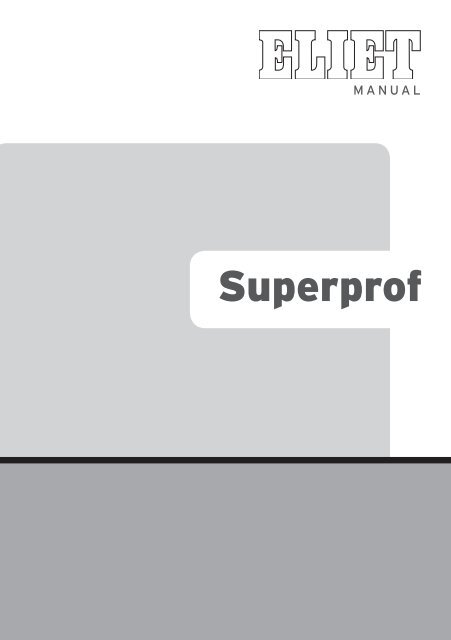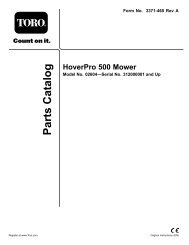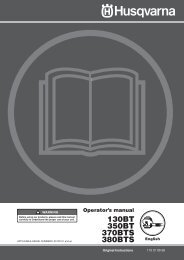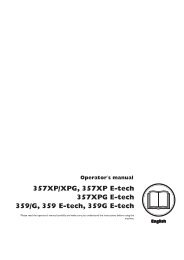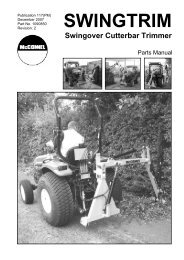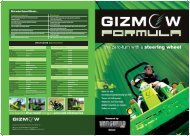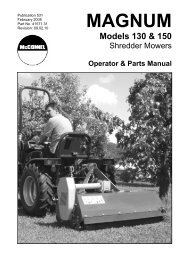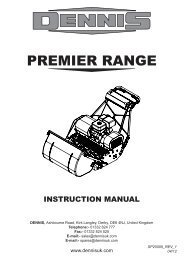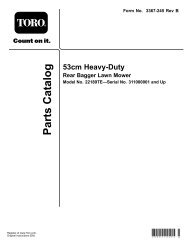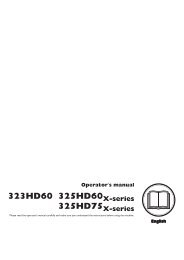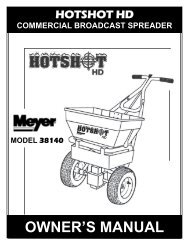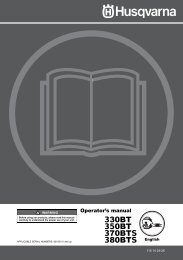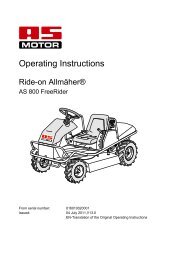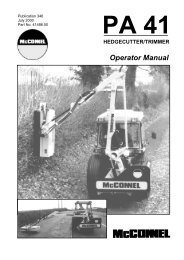Eliet Superprof Shredder Operators Manual (pdf - 1.4mb) - Gibsons ...
Eliet Superprof Shredder Operators Manual (pdf - 1.4mb) - Gibsons ...
Eliet Superprof Shredder Operators Manual (pdf - 1.4mb) - Gibsons ...
You also want an ePaper? Increase the reach of your titles
YUMPU automatically turns print PDFs into web optimized ePapers that Google loves.
MANUAL<strong>Superprof</strong>
English2
1. IntroductionEnglish1.1 Carefully read this user manualElite machines are designed for safe and reliable use if they are operated in accordance with theinstructions given. Carefully read this user manual before using the machine. Failure to observethis may result in personal injury or damage to the equipment.1.2 Identification data – ELIET 2000Note the identification data relating to your machine in the boxed areas.Product code :Serial Number :Year of Manufacture :Date of purchase :2. Warranty2.1 Warranty cardTo be eligible to obtain warranty you must mail the completed warranty card within one month ofthe date of purchase to the address stated below.European customers : US customers :ELIET NV ELIET USA Inc.Zwevegemstraat 136 3361 Stafford street (office B)B – 8553 Otegem (Belgium)15204 Pittsburgh (PA)T (+32)(0)56 77 70 88 - F (+32)(0)56 77 52 13 T 412 367 5185 - F 412 774 1970www.eliet.be, e-mail: service@eliet.bewww.elietmachines.comRead the warranty conditions on the attached warranty card.3
3. WelcomeEnglishWelcome to the family of ELIET customers.We would like to thank you for the confidence that you have placed in ELIET and we are convincedthat you have purchased the very best machine. The operating life of your ELIET machinedepends to a great extent on how you care for your machine. This user manual and the enginemanual provided will assist you in this respect. If you follow the instructions and suggestions inthese manuals, your ELIET machine will operate for a very long time in optimal condition.Read this instruction manual carefully before operating this machine. This will prevent you fromoperating the device incorrectly.For your own safety, take into account the safety instructions stated in the relevant chapter. Evenif you are thoroughly familiar with operating such equipment, it is still advisable to read thesepages carefully.At ELIET all our machines and devices are subjected to a policy of continuous change and therefore,the specification of your machine may differ slightly in terms of shape, technology and accessories.The descriptions and technical data in this manual are accurate at the time of printing.Certain illustrations and descriptions may not be applicable to your specific machine, but insteadrelate to a different version of the machine. In turn, we trust that you will understand that thetexts and illustrations in this manual cannot lead to any claims.If you still have any questions after you have read this manual, we request you to contact yourELIET dealer.ELIET AT YOUR SERVICEEuropean customers GMT +1 : from 08:00 to 18:00 HRSZwevegemstraat 136 Phone : (+32) (0)56 77 70 88B-8553 Otegem Fax : (+32) (0)56 77 52 13Belgium Email: service@eliet.be4
WarningEnglishOPERATING OUTDOOR POWER EQUIPMENTUnder the laws of several countries or states you are not permitted to operate an internal combustionengine using hydrocarbon fuels on any forest covered, brush covered or grass coveredland or on land covered with grain hay or other flammable agricultural crop, without anengine spark arrester in continuous effective working order.The engine on your power equipment, like most outdoor power equipment, is an internal combustionengine that burns gasoline, a hydrocarbon fuel.Therefore, your power equipment must be equipped with a spark arrester muffler in continuouseffective working order. The spark arrester must be attached to the engine exhaust system insuch a manner that flames or heat from the system will not ignite flammable material.Failure of the owner/operator of the equipment to comply with this regulation is a misdemeanourunder certain law (e.g. Californian Law), and may also be a violation of other state and or federalregulations, laws, ordinances, or codes. Contact your local fire marshal or forest service for specificinformation about what regulations apply in your area.The standard muffler installed on the ELIET engines is not equipped with a spark arrester. Onemust be added before use if this machine is intended to be used in an area where a spark arresteris required by law. Contact the local authorities if these laws apply to you. See your authorizedengine dealer for spark arrester options.ELIET AT YOUR SERVICEUS Customers GMT +6 : 8 AM till 6 PMPhone : 412 367 5185Fax : 412 774 1970service@elietmachines.com5
4. Table of ContentsEnglish1. Introduction ................................................................................................................................ 31.1 Carefully read this operating instruction manual. ............................................................................ 31.2 Identification data - ELIET <strong>Superprof</strong> .................................................................................................32. Warranty .................................................................................................................................... 32.1 Warranty card ........................................................................................................................................... 33. Welcome to the family of ELIET customers ........................................................................... 44. Tableof Contents ....................................................................................................................... 65. Safety symbols .......................................................................................................................... 85.1 For your information ...............................................................................................................................85.2 Caution ......................................................................................................................................................85.3 Warning .....................................................................................................................................................86. Main parts .................................................................................................................................. 97. Safety instructions ..................................................................................................................117.1 Safety messages .......................................................................................................................................117.2 Safety features .......................................................................................................................................147.3 Safety instructions.................................................................................................................................167.3.1 General safety regulations ............................................................................................................167.3.2 Careful and proper use .................................................................................................................177.3.3 Responsibilities of the operator .................................................................................................177.3.4 Personal protective equipment ..................................................................................................187.3.5 Risk zone ..........................................................................................................................................187.3.6 Periodic maintenance ...................................................................................................................187.3.7 Preserving nature ..........................................................................................................................198. Dealer preparation ...................................................................................................................199. Safety instructions .................................................................................................................209.1 Preliminary checks ............................................................................................................................... 209.2 Filling up with petrol ........................................................................................................................... 209.3. Preparing the work area .....................................................................................................................219.4 Starting the petrol engine ...................................................................................................................219.5 Moving the machine.............................................................................................................................239.6 Operating the machine .......................................................................................................................249.6.1 Before starting work .....................................................................................................................249.6.2 Shredding proper ........................................................................................................................259.7 Troubleshooting ....................................................................................................................................279.7.1 Rotor stalled ....................................................................................................................................279.7.2 Engine cuts out and the oil level pilot light comes on ..........................................................289.7.3 Engine stalls while running .........................................................................................................289.7.4 Motor does not operate at all during starting ........................................................................289.7.5 Capacity decreases .......................................................................................................................289.7.6 Wheel drive does not operate when petrol engine is running. ..........................................286
9.7.7 Feed roller no longer operates ...................................................................................................289.7.8 Engine no longer runs and the machine must be moved. ...................................................289.8 Cleaning the machine ..........................................................................................................................2910 Transporting the machine ..................................................................................................... 3011. Maintenance tasks described in detail ...................................................................................3111.1 General ......................................................................................................................................................3111.2 General interventions ..........................................................................................................................3211.2.1 Removing the belt guard .............................................................................................................3211.2.2 Removing the chain guard .........................................................................................................3211.2.3 Disconnecting the battery: ........................................................................................................3311.2.4 Opening the shredding chamber ..............................................................................................3311.3 Engine maintenance ............................................................................................................................3311.3.1 Checking the oil level in the engine crankcase + refilling ....................................................3411.3.2 Engine oil change .........................................................................................................................3411.3.3 Replacing the oil filter .................................................................................................................3511.3.4 Cleaning the air filter ..................................................................................................................3511.3.5 Changing the air filter .................................................................................................................3611.3.6 Changing the engine fuel filter .................................................................................................3611.3.7 Adding additional battery acid ..................................................................................................3611.4 Machine maintenance .........................................................................................................................3711.4.1 Checking and sharpening the blades .......................................................................................3711.4.2 Reversing and renewing the shredding knives .....................................................................3911.4.3 Checking the drive belt for correct tension ............................................................................4111.4.4 Tightening the V-belt ...................................................................................................................4111.4.5 Checking the tension of the drive chain for the feed roller ..............................................4211.4.6 Checking and adjusting the tracks for correct tension ......................................................4311.4.7 Changing the hydraulic oil and oil filter ..................................................................................4311.4.8 General lubrication ..................................................................................................................... 4411.5 Maintenance schedule ....................................................................................................................... 4811.5.1 Normal maintenance schedule ................................................................................................. 4811.5.2 Specific maintenance schedules ............................................................................................. 4811.5.3 Daily maintenance ...................................................................................................................... 4911.5.4 Maintenance after 50 hours..................................................................................................... 4911.5.5 Maintenance after 100 hours (or six-monthly) ..................................................................... 4911.5.6 Maintenance after 200 hours (or annually) ......................................................................... 5012. Winterizing the machine ........................................................................................................5113. Options ....................................................................................................................................5213.1 Sieve screens .........................................................................................................................................5213.2 Conveyor belt .......................................................................................................................................5314. Equipment specifications .....................................................................................................5715. EC Declaration of Conformity ..............................................................................................58EnglishAppendix A ...................................................................................................................................597
5. Safety symbolsEnglishCertain symbols in this manual are used to provide additional information and to draw your attentionto potential risks.5.1 For your informationFor your informationThis symbol is used to draw your attention to specific information and/oractions, or to denote where you can find additional information relating to thesubject.5.2 CautionCaution :This notice identifies safe usage habits. This is done to prevent incorrect actionsthat can result in personal injury or damage to the machine.5.3 WarningWarning :This notice is used to warn you about extreme danger that you must be awareof in these specific circumstances. Thus remain alert, in order to ensure yourown safety.8
6. Main partsTo fully understand the content of this operator’s manual, you need to be fully conversant withthe terminology used for[www] the descriptions. In this chapter you can find a set of parts identifiedby name. It is a good idea to take time to study the machine beforehand for an improvedunderstanding of the descriptions provided in this user manual.English1) Safety handle2) Wheel drive control / steering wheel3) Petrol tank4) Hydraulic oil tank5) Protection guard6) Loading hopper➀ ➁ ➂➃➄➅1) Ignition key2) Hours run counter3) Throttle4) Warning light ABM (green)5) Warning light engine oil low (red)6) Choke9
English1) Safety screen2) Instrument panel3) Foot brake4) Feed roller5) Sieve screen6) Knife drumFor your information :Reference in this manual to right or left hand side, back or front of the unitis observed from the machine operator facing the branch feedof the machine.Your ELIET dealer is at your service, ready to provide you with maintenance or advice so thatyour ELIET machine always remains in optimal condition. You can contact him for genuine ELIETservice parts and lubricants. These service parts are manufactured to the same stringent accuracyrequirements and standard of craftsmanship as the original equipment.Caution :For your safety, use only genuine ELIET partson ELIET machines.10
7. Safety regulationsEnglish7.1 Safety messagesBQ 505 010 050BQ 505 010 150Decal location (1 and 2) : filling of the oiltank. Sticker (1) uses icons to denote all thegeneral safety regulations.Read this user manual carefully in itsentirety before attempting to operate thismachine.Always wear the appropriate protectivegarment when operating the machine(protective gloves, safety goggles, hearingprotectors).Performing maintenance or operating themachine can be source of hand injuries. Beattentive and careful.Sticker (2) reminds the user to keep bystandersa safe distance away (10m).BQ 505 010 100Sticker (1) affixed to the feed opening warnsthat no attempt should be made to put yourhands past the safety screen. While sticker(2) located on the safety screen warns theuser of the danger of hand injuries and offlying debris. These are two risks – inherentin chipping branchy material –which arecatered for by the safety screen.BQ 505 010 12011
EnglishBQ 505 010 130These stickers on the safety covers ofboth the V-belt and the chain warn theuser that a V-belt or chain is fitted behindthe shielding panel. It is strictly forbiddento operate the machine with the safetyguards removed.Sticker affixed to the top of the safetyscreen. Warns the user of the danger ofhand injuries once the screen has beeneased away.BQ 505 010 070BQ 505 010 160This decal is affixed to the back of themachine at the safety screen. Thissticker reminds the user of the machineto examine the bolts retaining the bladesfor security of fixings within the 5-hourbedding-in period of fitting new blades orreversing existing blades.This decal is displayed on the side of theloading hopper. The legend specifies theguaranteed A-weighted sound power levelLw(A) emission from the machine undercalibrated conditions.BQ 505 112 11612
This decal is located on the side of theloading hopper. It lists all the identificationdata relating to the machine :Model, model number, serial number, yearof manufacture, engine, power rating,weight, guaranteed A-weighted soundpower level Lw(A).EnglishThis sticker also lists the manufacturer’s details. The CE label means that the machine complieswith the governing European machinery directive.Caution :Safety stickers becoming damaged, illegible or removed through use or cleaning,must be immediately renewed. Stickers are available at your approved ELIETDealer.The following stickers apply exclusively to our American Customers :< This sticker summarizes in 18 items a number of important safetymessages taken from the user manual. Caution : However, this does notimply that there’s no need to read the manual. (Order number : BQ 505010 200)BQ 505 010 180^ This sticker is located on the battery support tray. It warns the user ofthe potential hazards of battery acid.(Order number : BQ 505 010 180)BQ 505 010 190^ This sticker is located on the loading hopper at the infeed opening. Itreminds the user to operate the unit observing the stated capacity.(Order number : BQ 505 010 190)BQ 505 010 20013
EnglishBQ 505 010 250This sticker is located near the motorstarter mechanism. Each time themachine is started, the operator is remindedto inspect and service the bladesbefore turning on the machine. (Ordernumber : BQ 505 010 250)BQ 505 010 240This sticker is found near the identification sticker. Here, ourAmerican customers will find the phone number for technicalsupport in case of problems. (Order Number BQ 505 010240)7.2 Safety provisionsSafety screenThe safety screen (1) avoids access to theblades. No tools are required to open thescreen, but the motor is shut off on openingthe screen. The motor can be turnedon again once the screen is closed, that is,when the safety limit switch (2) is actuated.Chain and belt guardsThese guards provide protection from the moving belt and chain. These guards can only be removedusing tools. The machine must not be started if these guards are not correctly fitted.14
Sound absorption:The acoustic housing accommodating the knife drumgives excellent noise reduction whilst shredding, therefore,minimising noise nuisance for both the operator andthe surroundings.EnglishRugged construction :The robust construction not only adds to the long operating life of the machine, but also providesadditional user safety whenever there is an unforeseen emergency.Safety handle (1) :If you press the bottom of the safetyhandle, the feed roller stops as soonas this handle reaches position 3. Ifyou move the handle to position 2, thefeed roller pulls the material into themachine. If you move the handle toposition 1, the feed roller rotates in theopposite direction so that any materialthat has been fed in is ejected.Operating positions of the safety handleCaution :The description above is applicable to the operator moving the bottomof the safety handle. If the operator moves the top of the safetyhandle, then the numbers of the control positions are reversed.Safety screen (legend 2 above) :The safety screen is specially designed to protect the operatingpersonnel against flying wood chips Any attempt by the operator to insert his hands beyond thissteel sheet is strictly forbidden.15
EnglishSafety wear :For your safety, we strongly recommend to use the safety kit suppliedas standard. It contains your Personal Protective Equipment(PPE). This safety set consists of safety glasses, ear defendersand a pair of riggers gloves.7.3 Safety regulations7.3.1 General safety precautions• The Owner <strong>Manual</strong> must stay with the unit during its complete service life. It serves as a referencefor the user, and enables the machine to be used and maintained in accordance with thecorrect instructions. Always refer to this instruction manual if you have any doubts about anaction that you are about to perform.• If the instructions stated in this manual are not clear to you, do not hesitate to contact your<strong>Eliet</strong> dealer for further explanation. ELIET’s helpdesk (+32 (0)56 777088) is also at your disposalduring office hours to provide answers for your questions.• Read the chapter that is meant for the dealer (see Chapter 8) and immediately check whetheror not the machine has been delivered in accordance with the instructions.• Carefully observe all safety instructions when using the ELIET machine ! Carefully read all theinstructions relating to the use of the machine. All these instructions relate to your personalsafety.• When you purchase the machine, first allow the dealer or a professional to give you some instruction.• Read and observe all safety messages posted on the machine in the form of stickers.• Read and observe all safety messages posted on the motor.• Under no conditions whatsoever may the original design of the machine be modified withoutwritten consent of ELIET.• Under no circumstances must a safety item be shunted, disassembled or switched off.• As shredding involves ongoing considerable physical effort, take regular breaks for food intake,rest and drinking.• It is unsafe for persons suffering heart problems and/or having balance disturbances to operatethe machine.• Avoid inhaling the exhaust fumes from the machine. Exhaust gases contain toxic particles whichcould prove fatal. Never start the engine in an enclosed area.7.3.2 Careful and security-conscious use• This machine is designed solely for shredding branchy material, prunings, leaves and all kinds oforganic garden debris. Any use other than the designated operation is at the risk and responsibil-16
ity of the operator.• Never attempt to shred branches that are frozen.• Think about what you are doing whenever you operate the machine. Do not be tempted to letroutine dull your attention. Never act impulsively or in reflex.• Despite the extensive safety features, do not seek out dangerous situations.• Take care to preclude any tools falling into the in-feed funnel.• Do not feed foreign materials. (string, stones, metal, plastic, textile, etc.)• According to the manufacturer, this model will take branches up to 120 mm diameter. For yourown safety on no account should any attempt be made to introduce stems thicker than thestated capacity.• The machine is not designed to be subjected to the stated maximum capacity for longer periods.As a guideline: no more than 10 % of the garden waste that is to be fed into the machinemay have a diameter in excess of 90 mm.• Never stand on a step when feeding garden waste into the loading hopper.• Do not use a fork or a shovel to or a fork to feed the machine with garden waste.• Do not use your feet to feed garden waste in the loading hopper.• Never work in conditions where light intensity is less than 500 Lux.• Always remember to lock the wheels under shredding, so as to prevent the machine form moving.• For deontological reasons, ELIET accept no responsibility whatsoever for any accidental injuryto pets or persons caused by its machines.English7.3.3 Responsibilities of the Operator• All persons using the machine are assumed to be fully conversant with the safety instructions.• The operator is fully liable for the use of the machine in regard to himself and to third parties.• <strong>Operators</strong> are presumed to possess a certain level of maturity that permits them to make decisionsbased on common sense.• Underage persons must not operate the machine. However, this does not apply to youths abovethe age of 16 years, who are learning to operate the machine under the supervision of an experiencedoperator.• A disabled person may only operate the machine when under the supervision of an experiencedoperator.• Children and animals must be kept well away from the machine.• ELIET recommend that the machine should not be lent to others. However, if this is done, onlylend it to persons who are conversant with the machine.Always ensure that the user is aware of the potential hazards and ensure that hereads the manual before he uses the machine.(an indicative list of potential hazards can be found at Appendix)• This machine must only be operated by persons who are in good physical condition. If youbecome tired during the work, take a rest in due time. Persons consuming alcohol or drugs mustnot operate this machine.17
7.3.4 Personal Protective Equipment (PPE)English• You must wear suitable clothing to operate this machine. That is, clothing covering the wholebody, heavy protective gloves and closed nonslip footwear.• Do not wear loose fitting clothing (a shawl, for instance, should be avoided by all means). Longhair should be contained using a cap or a headband, or worn in a ponytail.• For the protection of the most sensitive senses, ELIET recommends ear defenders and safety goggles.• Shredding may result in dust production. If this dust irritates your lungs, we recommend thatyou wear a dust mask conform to directive 89/686/EC.7.3.5 Zone of dangerGraphical representation ofthe zone of danger• During the work, do not allow bystanders to enter the zone of danger that stretches up to 10maround the machine. Do not take any risks and immediately stop the machine as soon as anyoneenters the danger area.• When leaving the machine, the engine must be switched off. Always wait until the blades cometo a complete standstill before carrying out any operation. Once the engine is running, focus allyour attention on operating the machine.7.3.6 Periodic maintenance• Periodic maintenance is essential. For this reason, strictly follow the maintenance schedule inthis user manual (see Chapter 11).• A maintenance counter will help you keep track of the hours run (contact <strong>Eliet</strong> for additionalinformation).• When replacing parts as a result of wear or failure, always request genuine ELIET service partsfrom your ELIET dealer. This is important in the interests of your own safety.• Always make sure the engine is switched off and the battery cables disconnected before performingrepairs or maintenance.For your informationAlso, read the engine manual that comes supplied with the machine. Thiscontains the information required for the correct use and maintenance of theengine.18• Also read the engine manual, in order to carry out all maintenance according to the safety rulesgiven by the engine make.
7.3.7 Preserving NatureUse the machine in a manner that respects environmental regulations.• Avoid unnecessary machine running while not at work.• Avoid spilling petrol while refuelling.• Service the engine regularly in order to achieve optimum combustion.• Prevent battery acid from overflowing.English8. Dealer preparation• As an ELIET dealer you should familiarise your customers with the functioning of the machineand also point out the possible dangers while using it.• You are expected to carefully go over the maintenance points of the machine together with thenew owner. Repeat these instructions until the new owner has fully understood everything.• The need for pointing out the following issue to the customer is something cannot be over-emphasized:• All the bolts retaining the blades must be examined for security of fixings after the first 5operating hours. (Torque loading 40Nm)• Likewise, make sure to check the belt for correct belt tension after a run-in period of 10 hours.• Each machine that leaves the factory contains a limited amount of oil and fuel. The dealer mustcheck the levels of the oil and fuel and top them up in accordance with the instructions in thismanual (or in the engine manual).• The Dealer performs a test run on the machine and confirms that everything is functioningproperly (such as the safety contact at the collection bag).• He also checks that the bolts securing the blades are fully tight.• Lastly, the dealer makes sure that the warranty card is filled in completely and signed. This, inorder to avoid any warranty disputes. For more information, please read the warranty conditionson the warranty card.19
9. Operating instructionsEnglish9.1 Preliminary checksCaution :Before starting to shred, always run through the checklist below.Checklist1. Check the oil level of the machine. (see § 11.3.1 Checking the oil level of the engine).2. Ensure there is enough petrol in the tank. If necessary, fill up the tank with petrol.(see Chapter 9.2 Filling up with petrol)Check whether the air filter is not too dirty. (if considered necessary, see Chapter 11.3.3 Cleaningthe air filter)4. Satisfy yourself that the shredding knives are firmly in place and in good condition.If they need to be sharpened, this must be done first (Chapter 11.4.1).If one detects cracks or fractures in a blade, this blade must be immediately renewed.(see Chapter 11.4.2 Reversing and renewing the shredding knives).For safety’s sake, tighten the balde bolts. (see the list in annex for bolt torque loading)5. Check whether all safety provisions on the machine still operate.(see Chapter 7.2 Safety features).Once these items have been checked and approved, you can prepare the area of operation (seeChapter 9.3) and move the machine to the work site.9.2 Filling up with petrolTop up if the machine runs short of petrol. It’s a good idea to only use fresh petrol (see Appendix A).Use lead-free petrol, preferably 98 or 99 octane. Any other fuels are prohibited. (read the enginemanual).Warning :Under certain conditions, petrol is highly flammable and extremely explosive.Fire and explosion caused by petrol can result in serious burns or damage toproperty.20
• Do not add fuel while engine is running. Always allow a few minutes for the engine to cool offbefore topping up with fuel.• Only use fresh petrol.• Never add oil to fuel.• Because of the short shelf life of fuel, it is good practice to buy fuel in small quantities.• Store petrol in an approved container. Keep this container out of the reach of children.• Store fuel in a well-ventilated area away from open flames, sparks and heat sources.• Never top up fuel at a location where work is to be performed later. Always keep all persons atleast 10 m away from the work area. This is done to prevent any fires fromoccurring.• Clean the area around the fuel tank cap (1) and then remove this cap. Neverfill a tank to over 85% of the tank’s capacity. Top up with fuel until the levelis approximately 20 mm from the top of the tank. In short, do not fill the tankcompletely to the tank filler opening.• Always use a funnel or spout to pour the petrol into the tank. Suitable funnelscan be obtained from your ELIET dealer.• Refit the cap onto the tank as soon as possible.• Be careful not to spill petrol onto clothing.If petrol does come into contact with your clothing, change this clothing at once.• It is unsafe and thus expressly forbidden to fill the fuel tank in the vicinity of smokers or naked flames.• If fuel comes into contact with the eyes or is taken internally, obtain medical attention immediately.English9.3 Preparing the work area• Clear the area first where the machine is to be used. In addition, the paths along which theplant trimmings are removed, must be kept clear, thus releasing the operator from the worries oftripping up over them. The operator must also ensure that his safety is not compromised.• Make sure to locate the machine such that flying chippings expelled from the discharge outputdo not cause damage to persons or properties.• On slopes, never operate the machine (no forward, backward or lateral slope).• Make sure to sort the material beforehand. In this way, the operator is sure that no foreignobjects will enter the machine with the material.• Foreign objects are defined as: any non-organic object or branchy material in excess of thestated capacity (such as metal, stone, plastic, pvc, cords,…). Some of these can cause seriousdamage to your machine or can be ejected, virtually as projectiles towards the user.• Aways position the machine so that the wind will blow the dust produced away from the engine.9.4 Starting the Petrol EngineCaution :Never start the machine if the engine cooling fins are not clean and free ofdebris to protect it form overheating.21
For your information :Also, read the engine manual.EnglishWarning :Never run the engine indoors. Exhaust gases contain toxic substances and maylead to intoxication or suffocation.Before starting the engine, check whether adequate oil and fuel is present in the engine. If necessary,read the following sections:Chapter 11.3.1 Checking the oil level of the engine.Chapter 9.2 Filling up with petrolWarning :Before starting up the machine, make sure to wear the ear defenders suppliedas standard.• Ensure the shredding chamber is empty. This is to avoid starter mechanism overloading.• Be sure the shredder hopper is empty (no tools…).• Make sure the safety grid is closed and the safety switch is actuated. If not, the machine cannot be started.• Move the throttle control lever (1) to the mid-position.• Close the choke lever (2) by pulling the knob.• Turn the ignition key (3) to the 1 position and make sure thered oil level pilot light (4) comes on. This lets you check thepilot light for proper operation.• Move the key to the 2 position ; the start motor cranks theengine and the green pilot light (5) of the ABM system willcome on for a few seconds.• Release the key when the engine starts.• Push the choke (2) fully home.• At ELIET, we recommend to keep maximum engine speed at 3,200 rpm. Never make any alterationsto this factory-set maximum speed setting.Warning :The drive shaft for the blades is directly driven by the engine. These blades arepermanently connected to and driven by the engine. This means that themachine becomes dangerous as soon as the engine starts running.The engine must therefore be switched off immediately if you encounter asituation where you no longer have control over the work.22
Switching off the engine :• Move the throttle control lever (1) to low speed (= tortoise).• The ABM pilot light (if fitted) will come on.• Turn the ignition key (3) to the 0 position and remove from the ignition switch.• Store the key in a safe place away from children and unauthorised persons.English9.5 Moving the machineA. If you either have a standard machine or a version with ABM.As the machine is not self-propelled, it is pushed or pulled to the work site with the engineturned off.Warning :the machine is a heavy piece of equipment. Know your own capability.Overuse of your back may cause prolonged pains, rheumatics and paralysis.Always seek assistance when lifting things that are too heavy for you.B. If you have a self-propelled machine (ZR type)• Start the engine (Chapter 9.4).• Move the throttle control lever so that the engine runs atlow speed (= tortoise).• Make sure that the safety handle is in the neutral position.• Moving the machine:Move the control handle forwards, then the machine willmove forwards. The more you move the control handleforwards, the faster the speed. The opposite also works:Turning the control handle backwards will cause the machineto move backwards at a speed proportional to the amount that you move the control handle.C. Lastly : If you have the Cross Country version(version with caterpillar tracks)• Start the engine (Chapter 9.4).• Move the throttle control lever so that the engine runs atlow speed (= tortoise).• Move the safety handle to the neutral position.• To move the machine, perform the following steps:NOTE: The control handle consists of two separate handles,where the left-hand handle controls the left-hand track, andthe right-hand handle controls the right-hand track.• To move the machine straight ahead (forwards or backwards) : Move both control handles at thesame time. Moving both control handles will cause the machine to move forwards, moving thembackwards will cause the machine to move backwards.23
Caution :If you do not move both control handles by the same amount, the machine willnot move in a straight line.English• To turn to the right: By moving the left-hand control handle (1) through a larger angle than theright-hand control handle, the machine turns to the right. The greater the difference between thecontrol handles, the faster the machine will turn.• To turn to the left: Move right-hand control handle (2) through a larger angle than the left-handhandle (1) will cause the machine to turn to the left.• To turn the machine on the spot: Move each handle in opposite directions.The machine may quickly change direction during a turn.WARNINGKEEP YOUR FEET SAFE !The operator must be on his guard and move the control handles carefully.TIP :It is a good idea to become acquainted with the characteristics of a self-propelled machine anddo so in a quiet spacious location without bystanders.Note :You can move the throttle control lever to increase the speed of the machine. This will increasethe speed of the engine. (Read the previous tip before operating the machine at working speed.)9.6 Operating the machine9.6.1 Before starting work• Wear proper apparel, protective gloves and safety equipment as instructed in this manual (seeChapter 7.3).• A good gardener is well organized and plans his work. This will enable you to have perfectcontrol to avoid accidents.• The wood should be systematically stacked before commencing the work : thick branches, thinbranches, leaves and damp products. Ensure that the material does not contain any foreignobjects.• Never run the machine in an enclosed area. If this is done, there is a danger of being poisonedby the exhaust fumes from the engine.• Always shred with the engine at full throttle.24
Caution :Once the engine is running, the shredding knives are rotating, therefore,irrevocably shredding anything that is introduced into the loading hopper.9.6.2 Shredding properEnglish• Be careful when performing work.While operating the machine, focus your concentrationcompletely on the work.• Drive the machine to the work site.• Open the back cover (1). This enables you tomake a larger pile of chippings.• Start the engine (if you didn’t already do this,Chapter 9.4).• Allow the machine to run idle for about 5 minutes.• Move the throttle control lever to full throttle.Warning :Remember : When shredding at temperatures around freezing,maximum branch size of branchy material is limited to 70 mm.For your information :Always shred at full throttle for the engine to produce its full power output.• Move the control lever to the centred position (position 2). Thefeed roller starts to turn and pulls the garden waste into the loadinghopper at a constant speed. The maximum lift of the feed roller is120mm.• Preferably, the operator’s position is next to the black loadinghopper to introduce the garden waste. In this way, flying chippingsfinding their way from below the safety screen that are expelled fromthe in-feed do not cause personal injury.• Feed the garden waste into the loading hopper and guide it towards the feed roller. In the caseof loose garden waste (leaves, etc.), use a branch to push the material up to the feed roller. (DONOT USE a shovel or a fork to do this).• Never use a step for feeding the loading hopper with garden waste.• No attempt should be made to use your feet to push garden waste in the loading hopper.25
Warning :Do not lean forwards to push material further into the loading hopperso that your hands NEVER go past the safety screen.English• By reducing the amount of material that you feed into the machine, it will operate more optimally.• In the case of branches, it is recommended to feed in the thickest part of the branch first.• It is preferable to feed thick branches into the left-hand side of the loading hopper.• You can determine the feeding-in speed as follows:- Without ABM: You listen to the sound of the engine: if you hearthat the engine speed decreases substantially, this indicates thatthe engine is encountering problems (speed decreases below 2500rev./min.). If this happens, stop the material from being fed in bymoving the control handle away from you (position 3). When theengine returns to its normal speed, you can restart the feed roller bymoving the control handle to the centre position (position 2).- With ABM: The feed roller stops when engine speed is too low (
With moist materials, it is best to use a sieve for damp products.(Order number : MA 002 001 001)• Read the fitting instructions in Chapter 13.1 on pag. 52• If the shredding chamber gets clogged up, switch off the machine to remove the blockage.Make sure to wait for the blades to come to a complete standstill, before carrying out any operationon the machine. For safety’s sake, disconnect the spark plug wire.EnglishWarning :In order to avoid personal serious injury or damage to properties,never operate the machine without a sieve screen fitted.• If you notice a foreign object in the garden waste in the loading hopper, perform the followingsteps:- Stop the feed roller by pushing the control handle to position 3.- Move the throttle control lever to the minimum position.- Stop the engine using the ignition key.- Remove any foreign objects.• If you notice a strange noise during the work, immediately stop shredding. Stop the engine andinvestigate the cause of the defect. Before proceeding, perform the necessary repairs.9.7 Troubleshooting9.7.1 Rotor stalls• Turn the key to the OFF position and remove it from the ignitionswitch. (see Chapter 9.4).• Open the shredding chamber (see Chapter 11.2.4).• Completely empty the shredding chamber and make sure thatno pieces of wood are wedged in the knife drum (1). If, despitethis, the knife drum is still jammed, this indicates a mechanicalproblem (e.g. a bearing that has seized, etc.).Caution :Wear protective gloves as the blades are razor sharp !27
9.7.2 Engine cuts out and the oil level pilot light comes on• Stop the engine and remove the ignition key.• Check the engine oil (see Chapter 11.3.1 ) ; if necessary, top it off.• If the oil level is OK, this problem could also be caused by an electrical defect.English9.7.3 Engine stalls while running• Safety cap open.• Oil low-level fault.• Out of petrol.• Electrical defect9.7.4 Starter motor does not operate during starting• Safety guard is open.• Battery is in a low state of charge.• Defect in electric circuits• Engine oil low-level fault.9.7.5 Capacity decreases• Dirty air filter.• Fuel filter in need of cleaning.• Dirty or fouled spark plug.• Blades are blunt.• Incorrect tension of V-belt.9.7.6 Wheel drive does not operate when petrol engine is running.• Safety handle is not in neutral position.• Defect in the hydraulic circuit.9.7.7 Feed roller no longer operates• Engine speed too low.• ABM in disorder (Contact your ELIET dealer).• Problem in the hydraulic circuit (valve).• Chain broken.9.7.8 Engine no longer runs and the machine must be moved.If the engine is not running, the rear wheels are no longer driven.• If you turn the control handle on the steering, you are still able to slowly move the machine (usingthe force of the operator).• If the latter is not possible, and the engine no longer runs due to a blocked rotor, you may wishto take off the drive belts. This ensures that the rotor is no longer driven and that the engine canbe restarted.28
9.8 Cleaning the machineIt is strongly recommended that you clean the machine as per Chapter 11.5.1 after each use.Failure to do so will :• Lead to premature wear of the bearings, gaskets and drive belts.• Increase the risk of fire.• Decrease the cooling efficiency of the engine.• Inability to detect fractures or cracks.• Have a detrimental effect on the paint coating and the safety stickers.EnglishWarning :A machine that is no longer in good working condition may compromisethe security of the user.Caution :Wear suitable clothing when cleaning.Gloves are required.• Use a dry cloth, a soft brush, etc. for cleaning. To remove grease and lubricants, use penetratingoil containing molybdenum disulphide. This spray lubricates and also dissolves rust.• It is useful to have compressed air in the vicinity so that you can use it to clean various components.• Pay special attention to cleaning the engine. in particular, the cooling fins and air inlet must bethoroughly cleaned in order to guarantee optimal cooling of the engine.• Pressure-washing of the machine is permitted. However, never point the water jet for long periodsin the direction of bearings, electrical contacts or filler caps. Water is known to be the maincause of corrosion and must, therefore, be avoided at all times.• A washing out of the lubricant is possible ; for this reason, plan a lubrication task after thoroughcleaning.• The engine manufacturer does not recommend water cleaning.29
10. Transporting the machineEnglish• Make sure to clear the shredding chamber before moving the machine. Make sure the infeedopening is free of branchy material.• The maximum allowable lateral slope angle amounts to 10%.• Use slip resistant ramps to load the machine into a van or a trailer. Make sure that they aresecurely attached to the vehicle or trailer.• Under no circumstances must the angle of the up and/or down ramp be greater than 20%.• Be careful and composed when loading and unloading the shredder so that the machine doesnot tip over and give rise to an accident.• When coming down the ramp, move down backwards facing the machine.• If gravity causes the machine to descend more quickly down the slope than is desired, quicklymove the control handle to the other drive direction. This enables you to hydraulically brake themachine.• Make sure to properly secure the machine tothe vehicle during transportation. Use the fixedparts of the vehicle frame to attach ropes. Twoattachment points (1) are provided for securingropes. Always be sure to use the parking brake(2).• Do not forget that the machine has a highcentre-of-gravity. Therefore use ropes to secureboth sides of the machine to the vehicle. This ensuresthat the machine is not toppled over whenthe vehicle goes around a bend.• Do not overload the vehicle. Refer to Chapter 14(specifications sheet) to find out the exact weightof the shredder.30
11. Maintenance tasks described in detail11.1 GeneralEnglishFor your information :The dealer’s personnel are always at your service. The ELIET dealer can alwaysrely on comprehensive support from ELIET NV, so that we can work together tofind a solution for any problem that you may have. For a repair or for the maintenanceof the engine, you can always contact your ELIET dealer or a maintenanceservice that is recognized by the engine manufacturer. If you need to contactthese services, please provide us with the Model Number and Serial Number ofboth the machine and the engine, and also describe the problem in detail.Caution :Only use genuine ELIET replacement parts These service parts aremanufactured to the same strict quality control requirements and degree ofcraftsmanship as the original equipment.For your safety, use only genuine ELIET parts on ELIET machines.Perform maintenance in a room intended for this purpose. This room must be• Spacious• Easily accessible• Well lit • Dust-free• Clean and tidy • QuietThese characteristics are important to enable maintenance to be performed in an optimal manner.Caution :Improper maintenance may subsequently compromisethe safety of the operator.Prior to doing service operations, first make sure to disconnect the battery cables.(Disconnect the + terminal)When performing maintenance, always wear gloves, and also safety glasses for some operations.These are included with the machine.31
EnglishTIP :The maintenance work described can essentially be performed by any person who possesses therequisite technical knowledge. However, ELIET recommend that the machine should be handed into an ELIET dealer for a major overhaul each year.Your ELIET dealer is always at your service for maintenance and advice. He stocks genuine ELIETservice parts and lubricants. His staff can always obtain advice and service from ELIET, so thatthey can provide you with an impeccable after-sales service.11.2 General interventionsWarning :For your own safety: After performing the maintenance, refit ALL guards.NEVER OPERATE THE MACHINE WITHOUT SAFETY GUARDS !11.2.1 Removing the belt guard• Ease the safety guard (1) sideways.• Remove bolt (2) (M8 SW 13).• Remove bolt (3) (M10 SW 17).• Remove the guard.11.2.2 Removing the chain guard• Ease the safety guard (1) sideways.• Remove the bolts (2) and (3) (M10 SW 17).• The safety guard can now be removed.32
11.2.3 Disconnecting the battery• Remove the belt guard (Chapter 11.2.1).• Disconnect the negative terminal (1) (black M6, SW 10).• Disconnect the positive terminal (2) (red M6, SW 10)EnglishCaution :First connect the positive terminal (2) (red M6, SW 10).And then the negative terminal (1) (black M6, SW 10).11.2.4 Opening the shredding chamber• Ease the safety guard (1) upwards.• Pull the lock (2) downwards.• Make sure that both clamps (3) are released.• Topple the shredding screen (4) downward.To completely remove the sieve, perform the following steps.• Remove the hairpin clip. (1)• Remove the rod. (2)11.3 Engine maintenanceWarning :When running, engines emit carbon dioxide: an odourless and colourlesspoisonous gas.Inhaling carbon dioxide can cause nausea, fainting or death.Start the engine outside.NEVER run the petrol engine powered machine in an enclosed area, even with the windows anddoors open.33
11.3.1 Checking the oil level in the engine crankcase + refillingEnglishInadequate oil in the engine will cause irrevocable damage to the engine. Therefore, regularlycheck the oil level as follows.• Park the machine on a level surface so that the engine is perfectlyhorizontal.• Switch off the engine and remove the ignition key from the ignition switch.• Take a clean cloth.• Remove the dipstick (1) and use a cloth to wipe it clean (the oil levelshown on the dipstick is not always correct the first time that thedipstick is removed). Therefore reinsert the dipstick and then remove itagain. The oil level must reach the “F”(Full) mark on the dipstick.• If not, top off (Note : do not overfill).• First clean the area around the filler cap (2) before topping up the oil.• Remove the filler cap and remove the dipstick so that the crankcase is ventilated.Caution :Topping off the oil level is a meticulous job :do not overfill the reservoirto extend engine life and maximize engine performance.• Gently replenish the oil reservoir. Regularly check the oil level on the dipstick (to see when thedesired level has been reached).• Only use the recommended oil (see Appendix A).• Once the crankcase is replenished with the correct oil, place the check plug back in position andsecurely retighten the oil filler cap.• Immediately clean away any spilled oil.Caution :Make sure that no dirt enters the crankcase via the filler cap.11.3.2 Engine oil changeWarning :Filling the engine with oil is performed in TWO steps:Read all of the text carefully!• Make sure that the engine is horizontal.• Allow the engine to run until it reaches normal operating temperature, then switch off theengine (and remove the ignition key).34
• Hold a receptacle (capacity 2 l) underneath the oil drain plug (1).• Open the fill cap (SW 22).(see photo in Chapter 11.3.1).• Open the sump plug (1) and allow the contents to drain into the receptacle.• Refit the oil drain plug (SW 22).• Partially fill the engine with 1L of fresh oil and refit the filler cap.• Start the engine and allow it to idle for 20 seconds.• Stop the engine and wait for 30 seconds.• Then gradually fill the engine with the rest of the oil until it reaches the“F”(Full) mark on the dipstick.• Immediately clean away any spilt oil.EnglishInsufficient oil in the engine can cause irrevocable serious damage to the engine.11.3.3 Changing the oil filter• This is performed during an oil change (see Chapter 11.3.2)• Swing the safety screen upwards.• Remove the belt guard (Chapter 11.2.1).• Hold a receptacle underneath the filter.• Remove the used filter (1) after allowing the oil to drain (if stubborn,use an oil filter wrench).• Apply a film of new oil to the sealing gasket of the new filter.• Screw the new filter onto the mounting base until the gasket justtouches.• Tighten the filter ½ to ¾ of a turn.• Add the recommended amount of oil in the manner described above.11.3.4 Cleaning the air filter• Undo the hold-down clamps retaining the cover of the air filter (1) and remove the cover.Caution :If the engine has just been stopped, the exhaust will still be hot.• Before removing the the filter, use compressed air to remove dirt and dustbuilding inside the filter housing.• Gently remove the pre-cleaner from the cartridge.• Remove the nut and the sheet of the filter medium first and then remove thecartridge. (Prevent the carburettor from becoming dirty).• Clean the pre-cleaner using liquid detergent and water. Dry the filter in a cleancloth, soak it in oil then dry the filter again in an absorbent cloth in order toremove the excess oil.35
• Clean the cartridge by tapping it gently against a flat surface.• Refit the cartridge (with the UP mark showing upwards) and screw down.• Refit the pre-cleaner to the cartridge.• Refit the cover and secure the cover using the hold-down clamps.English11.3.5 Changing the air filterThese actions are almost identical to cleaning the air cleaner (see Chapter 11.3.4). The only differencehere is that the cartridge is replaced.New air cleaners of the correct type are available from your ELIET Dealer or from an authorizedBriggs & Stratton service centre. (B&S order number 394018S)11.3.6 Changing the engine fuel filter• Switch off the engine and remove the ignition key from the ignition switch.Warning :Always allow the machine to cool down this is to avoid fire hazard or danger ofexplosion.• Loosen the retaining straps (2) and (3) (using a universal wrench).• Remove the filter from between the straps.• Insert the new filter (whilst taking note of the direction ofthe arrow marked on the filter). New filters are available fromyour local <strong>Eliet</strong> dealer or from a B&S service center. (B&S orderNumber 496629)• Retighten the straps.• Clean up any spilt fuel.• Start the engine and inspect for signs of leakage.11.3.7 Adding additional battery acidWarning :Battery acid is corrosive and therefore dangerous. Wear safety glasses andprotective garment and work in a well-ventilated area.• Switch off the engine and remove the ignition key from the ignition switch.36
• Check to be sure electrolyte level is between the minimum and maximum marks. Inspect the sixcompartments for correct level by looking through the transparent battery case.• If the level is not correct, unscrew the caps from the battery.• Use only distilled water to top up to the correct electrolyte level.• Refit the caps to the battery.EnglishCaution :Do not inhale vapours from the battery acid.During this maintenance, do not rub your eyes with your hands.Should battery acid splatter into the eyes or onto the face, rinse the affectedarea immediately with clean cold water.If there is any further discomfort, seek prompt medical attention.Wash your hands immediately after performing this maintenance.Note :NEVER add additional acid, add only distilled water.11.4 Machine maintenance11.4.1 Checking and sharpening the bladesCaution :As a precaution, remove the ignition key from the machine and disconnect thebattery (see Chapter 11.2.3) before performing maintenance on the machine inorder to prevent accidents.Sharp shred knives will give the machine optimum performance and provide maximum operatingspeed. Enhance your own work comfort by taking some time to check the blades, and if necessary,sharpen them.SHARP BLADES = OPTIMUM PERFORMANCEFor your information :The blades can be sharpened without having to disassemble them. Use a smallangle grinder with a grinding disc suitable for steel.37
Caution :Always wear safety glasses and hearing protection when grinding knives.Gloves are also mandatory for performing the maintenance work.EnglishWarning :The blade has two cutting edges (reversible blade). Even though one side of theblade can be blunt, the other side can still be razor sharp.Caution :Make sure that all chippings in the immediate vicinity have been removed.This minimises the risk of fire.• Open the shredding chamber (see Chapter 11.2.4).• Always grind the blade along the angled cutting edge (1).• Never grind the rear side of a blade. In the case ofRESIST TM blades, the profile is on the rear side. If yougrind away the teeth, the blade will lose a great deal ofits cutting force.• The grinding is performed by moving the grinding discalong the angled cutting-edge.• Avoid excessive grinding in the same location (preventlocal discoloration of blades; this denotes heating thatcauses the material structure to change locally and thehardness to decrease).• Retain the existing cutting angle.• The top of the knife is subjected to the heaviest loads during shredding. Sharpen this as little aspossible so that it is not weakened.Caution :Minimise the duration of the grinding as much as possible in order to preventheating up. If a blade becomes discoloured, this denotes heating, andsignificantly decreases the operating life of the blade.Correct and timely sharpening of the shredding knives will extend theiroperating life. If the top of the blade is rounded-off, the shredding efficiencywill be reduced. In this event, further grinding of the blade servesno purpose. This is the time to reverse or renew the blades.38
11.4.2 Reversing and renewing the shredding knivesWarning :Wear protective gloves as the knives are razor sharp !EnglishKnives sharpened at regular intervals ensure a knife life in excess of 50 hours for each bladeedge (100 hours withRESIST TM blades). When one cutting edge becomes worn, you can reverse the blade. If both bladeedges are worn, renew the knife as a set.A. To reverse a shredding knife, proceed as follows.• Open the shredding chamber (see Chapter 11.2.4).For your information :Reverse the blades as a pair (as shown in the photos) in order to work in anorganised manner.• Disassemble the blades by removing the two M8 bolts from each blade. In this situation alwaysuse two ring spanners fitted with long steels. (M8 SW 13)• If the bolts or nuts are damaged, they must be renewed.• Release the shred knives using a self-grip wrench.Changing the blades of group 1. (Blade pairs 1, 2, 3 and 4)• Remove a knife from the left-hand side, rotate it through 180° and fit it in the same position,but to the right-hand disk. Rotate the blade previously removed from the right-hand blade disk,and fit it in the empty hole drilled in the left-hand blade disk. Repeat this procedure for eachblade (8) of group 1.groupgroup39
Check :Check that the rear of each blade is towards the wall of the shredding chamber.If this is not the case, correct the blades that are incorrect.EnglishChanging the blades of group 2. (4 knife discs)• Disassemble two blades that are diametrically opposite each other. Rotatethem through 180° and change them over. Do the same with the tworemaining blades. Repeat this operation for the three remaining bladedisks of group 2.Check :The front side (bevelled edge) of each blade of group 2 mounted on afluted part of a blade disc must point towards the centre axis. When this isnot the case, adjust.B. To renew a shredding knife, proceed as follows.• New sets of knives are available form your ELIET Dealer under the following part number :STD blades: BU 401 300 201Resist TM blades : BU 401 300 302• When renewing the blades, simply remove the old blades and replace them with new blades.• First remove any dirt between the blade plates before you insert a new blade. To do so, use astripping knife.• Use the same procedure as for reversing the blades. See checks for both groups.• On renewing shredding knives, always fit new bolts and nuts.40
• When refitting the shredding knives check that all bolts are tight (torque loading : 40Nm).(Torque loading 40Nm).• When fitting the blades, always position the nuts on the (1) left-hand side of the blade plate. Thisorder of assembly ensures that the nuts are tightened by the direction of rotation of the engine.As a reminder: “Always position the nuts on the belt pulley (2) side.”• The bolts must be rechecked and, if necessary, tightened after 5 operating hours.EnglishCAUTION ! :Incorrectly installed or badly installed blades can pose a danger to the operatorand the machine. If this happens, you are no longer covered by the warranty.11.4.3 Checking the drive belt for correct tension• Remove the belt guard (Chapter 11.2.1).• Place an 8 kg load on the V-belt midway betweenthe two pulleys.• If this produces a 1 cm deflection, then belt tensionis correct.11.4.4 Tightening the V-belt• Loosen the guide bolts (5 & 6) and unscrew them 1.5 cm. (M10 SW 17)• Position a metal plate between the base of the engine and the bolt (6) and retighten this bolt.(M10 SW 17)• Partially unscrew the 4 bolts retaining the engine (1, 2, 3, 4) (M10, SW 17).• Push the engine forwards via the tensioning bolt (6). Ensure correct belt tension.41
English• Align the belt pulleys. To do so, use a straight slat (length : +/- 1200 mm)and hold it against both belt pulleys. When the alignment is correct, theslat will touch the belt pulleys at 4 locations.• Position a metal plate between the base of the engine and the guide bolt (5).• Then screw the guide bolt (5) further in to adjust the belt alignment.• When the belt is perfectly aligned, retighten the 4 tensioning nuts.• When the engine is tensioned, remove the metal plates between theengine block and the guide bolts (5 & 6) and screw the guide bolts untilthey just touch the engine block. Lock the guide bolts using the lock nuts(M10 SW 17).11.4.5 Checking the tension of the drive chain for the feed roller.• Remove the chain guard (see Chapter 11.2.2).• Check the tension of the chain.• If the chain is too slack, slacken the bolts (3 &5) (M8, SW13).• Tension the chain by tightening the nut on thethreaded rod (4). (M6 SW10)Caution :The tension on the chain must not be excessive.• When the chain tension has been adjusted to the correct value, tighten bolts (3 & 5) (M8, SW13).• Refit the chain guard. For this, use the two bolts (1) and (2). (M10 SW17)42
11.4.6 Checking and adjusting the tracks for correct tension (Cross Country model)A. Checking for correct tension :• Lift the track somewhere in the middle between the drive sprocket and the tensioner.• If you can lift it for about 1 cm from the tensioner, track tension is OK.• If not, the track needs retensioning.EnglishB. Adjusting the tension :- Loosen the 2 bolts (M10, SW17) first and then remove the guard protecting the track guides.- Unscrew the lock nut (2) (M12 SW19).- Screw in the central clamping bolt (3) (M12 SW19) until all the slack is taken up.- Check the tracks for correct tension and turn the clamping bolt (3) further inwards (or outwardsif track tension is too high).- Remember to tighten the lock nut (2) to secure the clamping bolt (3).- As you go along, thoroughly clean and lubricate the track holder.- Refit the guard using the 2 bolts using a reverse sequence to that given for removal.11.4.7 Changing the hydraulic oil and oil filter• Switch off the engine and remove the ignition key from the ignition switch.• Clean the area around the filler opening and suction pipe.• Open the filler opening (4) of the hydraulic tank.• Obtain a container that has a capacity of at least 15 l.• Remove bolt (1) and allow the oil to drain (M12, SW 19).• After the oil has been drained, remove the nuts (2) (M5, SW 8).• Cut away the jointing compound and remove the filter.43
English• Carefully remove any jointing compound residues so that no residues enter the oil tank.• Replace the filter.• Be over generous in the application of new jointing compound for a good seal.• Refit the filter and the drain plug.• Fill the oil tank with fresh oil (see Appendix A for recommended oil).• Clean off any spilled oil and inspect for signs of leakage.Caution :Do not allow the suction hose, oil plug and filler cap to become dirty.This minimises the chance of a hydraulic defect and premature wear.11.4.8 General lubricationIn view of the fact that the shredders often operate in extreme conditions, ELIET considers it importantto use high-quality materials. ELIET therefore recommends the use of special lubricants(from the assembly stage onwards).The following parts require regular lubrication:• Pivot points and friction surfaces (see A on page 42).• Grease zerks (see B on page 42).• Bearing (see B on page 43).• Chains and gears (see D on page 43).Caution :Before performing lubrication, make sure to switch off the engine and toremove the key from the ignition switch. Gloves must also be worn during thismaintenance.44
A. Lubrication of pivot points and friction surfacesEnglishThis group includes the following locations on the machine:Ground drive control pivot pointsBall joints of the hydraulic valvesNylon sealing plates for the feed roller guidesThrottle control lever pivot pointChoke leverQuick-closing sieve screening systemScreen locking pinPivot points of the safety guardWheel drive brake guideParking brake foot pedalUse the following procedure :• Whenever possible, disassemble the hinge or the joint.• Spray some penetrating oil containing molybdenum disulphide onto the frictions surfaces andallow the oil to penetrate.• Wipe away all traces of old lubricant and dirt.• In the event of some parts not being accessible, use compressed air to remove all traces of oldlubricant and dirt (e.g. in the joints of pivot points).• When the pivot points are clean, apply new lubricant.• ELIET recommends Novatio Clearlube as a lubricant for pivot points and ball joints. ELIET wouldrecommend Novatio PFT grease for friction surfaces.• Wipe away any excess lubricant.45
B. Greasing via the grease zerks fittedEnglishThis group includes the following locations on the machine:Grease zerk on the pivot point of feed roller (1)Grease zerks on pivot point of castors (2)Grease zerks on the bearings of the castors (3)Grease zerks on the track guide bearings (Cross Countrymodel)Use the following procedure :• Clean the grease zerk.• Using a suitable grease pump, apply new grease.• ELIET recommends Sunoco Multi Purpose Grease.• Pumping the grease gun one or two times is sufficient todistribute the grease.• Wipe away any grease that comes out of the joints.C. Lubricating the bearingsThis group includes the following locations on themachine:Bearing of the feed rollerBearing of the knife drumUse the following procedure :• Spray some penetrating oil containing molybdenumdisulphide into the bearing and the areaaround and allow the oil to penetrate.• Wipe away any external dirt.• Spray more penetrating oil into the bearing joints.• Allow the bearing to rotate (possibly by starting the drive that moves the bearing). (CAUTION:make sure that all dangerous zones are adequately shielded).• Once again, wiped away any dirt that is forced out by the penetrating oil.46
• Use compressed air to remove all traces of penetrating oil from the bearing and from the bearingjoints.• Apply new lubricating oil. ELIET recommends Novatio ClearLube as a lubricant.• Wipe away any excess lubricant.D. Lubricating the chains and the gearwheelsEnglishThis group includes the following locations on the machine:Chain drive of the feed roller.Use the following procedure :• Remove the guards to expose the drive (see Chapter 11.2.2).• Wipe away all grease in and around the drive.• Use penetrating oil containing molybdenum disulphide to dissolve the lubricant.• When the drive is clean and all traces of grease and dirt have been removed, you can apply newlubricant.• Use a small brush to apply the lubricant to the teeth of the gearwheels. Use Sunoco Multi PurposeGrease or a product of the same quality.• It is better to use a thin liquid lubricant that can penetrate into the chains. For this, ELIETrecommends Clear Lube lubricant spray from Novatio.• After applying the lubricant, the guards are carefully refitted in order to keep out dust and dirtas much as possible.All these greases are available from your ELIET Dealer.47
11.5 Maintenance scheduleEnglish11.5.1 Normal maintenance scheduleDaily (after each use) : Daily maintenance § 11.5.3Every 50 hours : Maintenance after 50 hours § 11.5.4Every 100 hours (six-monthly) : Maintenance after 100 hours § 11.5.5Every 200 hours (or annually) : Maintenance after 200 hours § 11.5.611.5.2 Special maintenanceA. Special maintenance of the bladesAfter inserting the blades into the rotor, the blades will bed-in after a brief period. This cancause the tension on the bolts to decrease, with the risk that the blades may become dislodgedbetween the blade plates. This can cause irrevocable fatigue failure of the blade shaft. This mustbe prevented by scheduling extra maintenance after the brief bedding-in period.When:Within the first five operating hours after starting up the new machineWithin the first 5 hours after rotating the bladesWithin the first 5 hours after changing the bladesWhat:Check all blade bolts for correct torque loading and retighten if considered necessary.(torque loading : 40 Nm)Warning :Failure to perform this special maintenance will compromise the safety of theoperators and bystanders and can cause serious damage to the machine.B. Special maintenance of the drive beltThe belt that transfers the power from the engine to the blade shaft is long. During the beddinginperiod, the belt will stretch naturally to a certain extent. This stretching will reduce the belttension. Using the machine when the belt tension is too low will cause the belt to slip, twist orwear down. These three possibilities have a detrimental effect on a new belt.When:Within the first 10 operating hours after starting up the new machineWithin the first 10 hours after changing a beltWhat: Check the belt tension (see Chapter 11.4.4)48
11.5.3 Daily maintenanceCaution :Before performing any maintenance, stop the engine and remove the key fromthe ignition switch.Wear suitable clothing.English• Check for signs of leakage.• Open the shredding chamber (see Chapter 11.2.4).• Clean the machine (see Chapter 9.8)• Inspect the blades, and if necessary, sharpen them (see Chapter 11.4.1)• Check the machine for signs of abnormal wear or fractures.• Check the bolts for correct tightness. (Blades, wheels, bearings, engine,…).• Check the oil level in the engine crankcase (see Chapter 11.3.1).11.5.4 Maintenance after 50 hoursCaution :Before performing any maintenance, stop the engine and remove the key fromthe ignition switch.Wear suitable clothing.• Daily maintenance (see Chapter 11.5.3).• Change the engine oil (see Chapter 11.3.2)• Clean the air cleaner. (see Chapter 11.3.4).• Check the belt tension (see Chapter 11.4.3).• Reverse STD blades (see Chapter 11.4.2)• Check the chain tension and, if necessary, adjust the tension. (see Chapter 11.4.5).• Check the level of hydraulic oil (see Chapter 11.4.7).• General lubrication (see Chapter 11.4.8).11.5.5 Maintenance after 100 hours (or six-monthly)Caution :Before performing any maintenance, stop the engine and remove the key fromthe ignition switch.Wear suitable clothing.• Maintenance after 50 hours (see Chapter 11.5.4).• Change STD blades or reverse RESIST TM blades (see Chapter 11.4.2)49
• Replace the oil filter (see Chapter 11.3.3)• Check the level of battery acid (see Chapter 11.3.7)11.5.6 Maintenance after 200 hours (or annually)EnglishCaution :Before performing any maintenance, stop the engine and remove the key fromthe ignition switch.Wear suitable clothing.• Maintenance after 100 hours (see Chapter 11.5.5).• Change RESIST TM blades (if fitted) (see Chapter 11.4.2)• Changing the hydraulic oil and oil filter (see Chapter 11.4.7).• Air cleaner change (see Chapter 11.3.5).• Changing the engine fuel filter (see Chapter 11.3.6).• Changing spark plugs (read the engine manual).• Checking the tracks (see Chapter 11.4.6 – Cross Country models only).After performing maintenance or a repair, make sure that you correctly refit ALL guards.50
12. Winterizing the machineEnglish• Clean the machine (see Chapter 11.5.1).• Store the machine in a dry place that is protected from rain, and if necessary, cover it with atarpaulin.• Always allow the machine to cool down before storage.• If the machine is to be stored outside, it must be well protected with a tarpaulin. Ensure thatwater does not directly fall onto the machine. At ELIET, we strongly recommend that the machineis stored at a location that is well protected from the weather, etc.• When winterizing the machine for long periods, it is recommended to perform the followingsteps.• Perform a 50-hour overhaul (see Chapter 11.5.4).• Check all nuts and bolts for correct tightness, and where necessary, retighten them.• Places where the paint coating is damaged are repainted or covered with grease in order to preventrust. Original ELIET paints in the same colour are available from your ELIET Dealer (articleno.: BX 043.200.400).51
13. OptionsEnglish13.1 Sieve screeningYou can choose from three types of sieves that can be easily interchanged.The three types are:• Sieve with 30 mm diameter holes : order number MA-006.001.008• Sieve with 35mm diameter holes : order number MA-006.001.009• Shredding screen for leaves and damp material : order number MA-006.001.006Sieve for leaves and damp materialFitting the sieve• Open the safety guard.• Open the sieve by pulling the clampbackwards (1).• Make sure that the hooks are completelyreleased.• Remove the hairpin clip (2).• Pull the rod (3) out and remove thesieve from the machine.• Change the sieve.• Refit the rod (3).• Check that the shaft correctly retains the sieve.• Refit the hairpin clip (2).• Place the hooks against the sieve.• Snap the clamp (1) shut. When the hooks are correctly adjusted, slight tensionexists. If this is not the case, loosen the lock nut (1) (M8 SW13), screw the hook (2)one turn inwards or outwards (according to whether too little or too much tensionexists) and then retighten the lock nut.52
13.2 Belt conveyorThe belt conveyor is installed at the rear of the machine and transports the shredded materialupwards. The length of the belt conveyor is 2.5m. The height of the belt conveyor can be adjustedfrom 1.65m to 1.90m. It is driven by a hydraulic motor that is independently activated. Care mustbe taken to ensure that the belt conveyor is switched on when you start feeding material.EnglishAttaching the belt conveyorCaution :Prior to fitting the belt conveyor to the machine, always be sure to switch offthe engine.• Remove the safety guard cover (M8, SW13)Warning :The cover is part of the safety guard and prevents you from coming into contactwith the blades. Removing this cover results in an inferior degree of protection.Be extremely careful and never insert your hands underneath the safety guard.• Refit the spring, flat washer and bolt into their locations place, so as not to loose them.• Using 2 persons, hold the belt conveyor at both sides.Caution :The belt conveyor weighs approximately 45 kg; do not underestimate thisweight.Prevent back injuries by bending your knees when lifting the weight.53
English• Hook the belt conveyor onto the attachment points (1) provided on the shredder.• Make sure that the hydraulic pipes do not become damaged during this operation.• Connect the quick fit connectors (prevent the connector ends from becoming dirty; if necessary,clean them first).• Close the safety guard and allow it to rest on the belt conveyor.• An additional switch valve, situated at the underside of the feed hopper, enables you to startthe belt conveyor.• Remove the locking pin (2) first and then press the control handle down.Note : After machine start-up, first switch on the discharge belt conveyor before feeding branchesinto the feeding hopper.Detaching the belt conveyorCaution :Always switch off the engine before removing the conveyor belt.• Open the safety guard.• Disconnect the hydraulic quick fit connectors.• Connect the two hydraulic pipes to each other in order to prevent damage or contamination.• Refit the blanking caps to the hydraulic quick fit connectors of the machine.• Using two persons, support the belt conveyor and unhook it.Caution :Do not underestimate the weight of this discharge belt conveyor.54
• Set the control to the OFF position and lock it using a hairpinclip.• Refit the cover in the guides of the safety guard.EnglishAdjusting the height of the belt conveyorYou can set the belt conveyor to an angle thus allowing you to change the loading height.For this, you must move the transverse beam (1) on which the belt conveyor rests at the rear ofthe machine.Several attachment holes (2) are provided.First detach the belt conveyor from the machine before unscrewing this transverse beam.Loosen the M8 bolts on either side (SW13). Move the transverse beam to another attachmenthole and then refit the bolts.Tighten the bolts so that the belt conveyor remains secure when it is operating.Hook the belt conveyor back onto the machine and check that the loading height is adequate.Checking the belt conveyor for correct belt trackingIn the event of inaccurate belt tracking, it must be aligned for true running.• Always check the belt conveyor for correct tracking when fitted to the machine.• Start the engine and switch on the belt conveyor. Allow the machine to run for two minutesuntil the shredding chamber is completely empty.55
Caution :Do not perform this maintenance in a confined area that does not havean extraction system for exhaust gases.English• Run the engine at low rpm (± 1,800 rpm).Warning :Always wear safety glasses to protect you from material kickback.• The guides at the top return roll enable you to set the conveyor for correct belt tracking.• When the conveyor tracks to the right, tighten the left-hand side by screwing the threaded rodon this left-hand guide down. If a substantial amount of tension already exists on the conveyor,you can try to move the conveyor to the left by loosening the guide on the right-hand side.• Never try to make too much adjustment at once; first allow the conveyor to stabilise so that youcan evaluate the result of your action.• If the conveyor tracks to the left, then perform the above procedure (but replace left with right).Checking the conveyor belt for correct tracking• Perform this maintenance with the engine switched off.• Support the conveyor halfway along its length on the underside of the frame.• Remove the conveyor from the frame.• The maximum conveyor misalignment is 50 mm.• If this misalignment exceeds 50 mm, the conveyor will run too loosely on the rollers with thiscausing increased wear.• Remove the bolts on the side of the tension guide. Screw the threaded rod in so that the guideretensions the conveyor.• If it is found that belt tension is correct, allow the machine to run for a brief period in order tocheck the alignment.• If necessary, readjust the tension. (see Chapter 13.2.3).• Once the conveyor belt runs true and tracking is OK, securely tighten the guide bolts.56
14 Equipment specificationsSuper Prof 2000STD ZR ZR-ABM CROSS COUNTRYNumber of chopping motions per minute 48000EnglishBranch shredding capacity (wheel barrows/hour) 48 48 60 60Branch capacity120 mmDimensions (L x W x H) 1830 x 835 x 1,380 mm 1830 x 900 x 1,330 mmWeight 332 kg 352 kg 355 kg 420 kgNumber of bladesShredding widthDrive24 HS steel reversible shred knives480 mmPetrol enginePower18 HPTransmission V-belt Gates Quad Power II XPB 2410Anti Motor Block system - - ABM-systemFeed roller toothed roller 18 m/min toothed roller 23 m/minInfeed opening (W/H)660 x 510 mmFeed-in height 1,005 mm 1,000 mmFrameFinish3 mm and 4 mm steel plateEpoxy polyesterWheels Rear wheels : pneumatic tyres 600 x 9 / 6 ply Tracks 180 x 37 x 72Front wheels : pneumatic tyres 400-4 / 4 plyWheel drive - Hydraulic motors : DanfossHydraulic pumpSound power levelAirborne sound power levelGuaranteed sound power levelEngine makeAccessoriesSauer Sundstrand 3.2 cc - 210 barLp(A) : 105 dB(A)Lw(A) : 115 dB(A)Lw(A) : 116 dB(A)B&S VanguardRESIST bladesSieve for damp productsSieve with 30 mm openingsSieve with 35 mm openings- Tractor tyres -Feed roller speed governorDischarge conveyor up to 2 mTrailer for quick transport57
15. EC Declaration of ConformityEnglishMachine Super Prof 2000Stock no. : MA 006 010 113Stock no. : MA 006 020 113Stock no. : MA 006 030 113Stock no. : MA 006 040 113Stock no. : MA 006 050 113The previously mentioned machine has been designed and manufactured to comply with the followingEuropean CE regulations :EN 13515: Forestry machinery : wood chippers - safetyELIET mfg. cy. hereby declares that after performing a hazard analysis, it is fully aware of thepotential hazards and risks associated with the machine. In this knowledge, the necessary stepshave been taken in line with Machine Directive 98/37/EEC in order to ensure absolute operatorsafety for the operator, when the machine is used correctly.The assessment of the airborne sound power level and the guaranteed sound power level wascarried out strictly in accordance with European Directive 2000/14/EG, annex III.Airborne sound power level LwA : 115 dB(A)Guaranteed A-weighted sound power level : 116 dB(A)Date : 01/01/2004Signature :Frederic LIETAERCEO ELIET COMPANYZwevegemstraat 136B - 8553 Otegem, BelgiumPhone : (+32) (0)56 77 70 88Fax : (+32) (0)56 77 52 13info@eliet.bewww.eliet.be58
Appendix ATechnical specifications of the lubricants and fuelEngine oil Synthetic oil SF, SG, SH, SJViscosity SAE 5 W 30 / SAE 10 W-30Capacity of engine crankcase1.6 LEnglishFuel Unleaded petrol (gasoline)Minimum RON 85Capacity of fuel tank7 LHydraulic oil Conforms to DIN 51524 Part 3 HVLPViscosity ISO VG 46 cStCapacity of hydraulic system15 LBrandsSUNOCO Sunvis 846 WR HVELF Hydrelf DS 46SHELL Tellus TD 46TOTAL Equivis ZS 46CASTROL Anvol WG 46TEXACO Rando HDZ 46MOBIL DTE 15 MESSO Univis N 46Lubricant for bearingsLubricant for pivot pointsLubricant for friction surfacesLubricant for chain transmissionLubricant for grease zerksNOVATIO CLEAR LUBENOVATIO CLEAR LUBENOVATIO PTFE OILNOVATIO CLEAR LUBESUNOCO MULTI PURPOSE LR EP259


